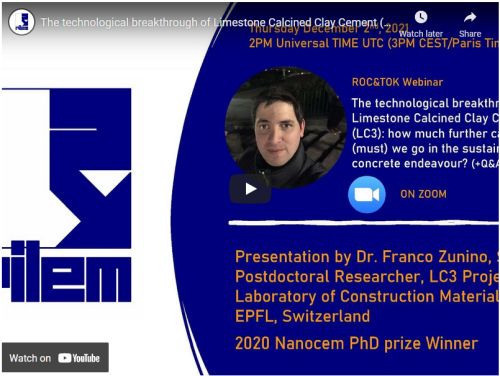Dr. Franco Zunino, winner of the 2020 Nanocem PhD Prize, will give a webinar organised by Rilem (International Union of Laboratories and Experts in Construction Materials, Systems and Structures) on Thursday, December 2nd, 2021.

The technological breakthrough of Limestone Calcined Clay Cement (LC3): how much further can (must) we go in the sustainable concrete endeavour?
Concrete is the substance used in largest quantity by mass after water, with a foreseen increase in the demand for the next decades. Portland cement (PC), the binder in concrete, accounts for about 8% of manmade CO2 due to this enormous consumption. LC3 provided a technological breakthrough towards more sustainable concrete, by enabling a cement with 50% clinker reduction, equivalent performance to PC and enhanced durability. LC3 saves about 40% of CO2 compared to traditional PC.
Understanding the underlying mechanisms of LC3 hydration and microstructural development were, and still are, key elements to optimize and transition this technology to the industry. From raw material extraction and processing, blend design and optimization, mechanical properties characterization and durability assessment, fundamental and applied science will continue to facilitate adoption of LC3 in every specific use-scenario. In this regard, the high reactivity of calcined clays and the additional potential of the clay-limestone synergy open possibilities for further clinker reductions. Moreover, it is only by a simultaneous consideration and optimization of the cement and concrete scales that we can achieve the highest CO2 reduction potential and approach the ultimate green-concrete we need.